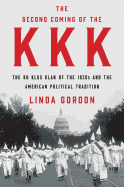
In her concise account of white supremacy, The Second Coming of the KKK: The Ku Klux Klan of the 1920s and the American Political Tradition, historian Linda Gordon dispenses with preconceptions of backwoods Southern racists and instead reveals a well-mobilized social movement sweeping across the nation.
With smart, lively prose, Gordon (Feminism Unfinished) reexamines conflicts of the past. From the outset, she declares, "I cannot and do not wish to discard my values in interpreting the past." In delving into the United States's painful legacy of racism, Gordon never sympathizes with the cause. She instead dissects the underlying social structures of the KKK to understand better its persistence in American culture. In the 1920s, Gordon explains, the KKK experienced a popular resurgence. Unlike the 19th-century Klan, which sought to subjugate freed blacks, the 20th-century iteration widened its antipathies to include Hispanics, Catholics, Jews, liberals and immigrants.
Gordon's expert research is disturbing on many levels. The 20th-century Klan used democratic methods to become a giant service club and political organization--a bastion of WASP identity--that found allies not only in right-wing Christian sects, but also in many labor and feminist circles. The rallying cry of white supremacy spurred a populist movement that cast white citizens as heroes trying to rescue their nation from insidious outsiders and moral polluters. At her incisive best, Gordon uncovers the spurious psychology behind this movement. The most troubling thing about The Second Coming of the KKK is its relevance to 21st-century American politics. The parallels are clear, though Gordon doesn't force any conclusions. Readers are left to draw their own. --Scott Neuffer, writer, poet, editor of trampset

